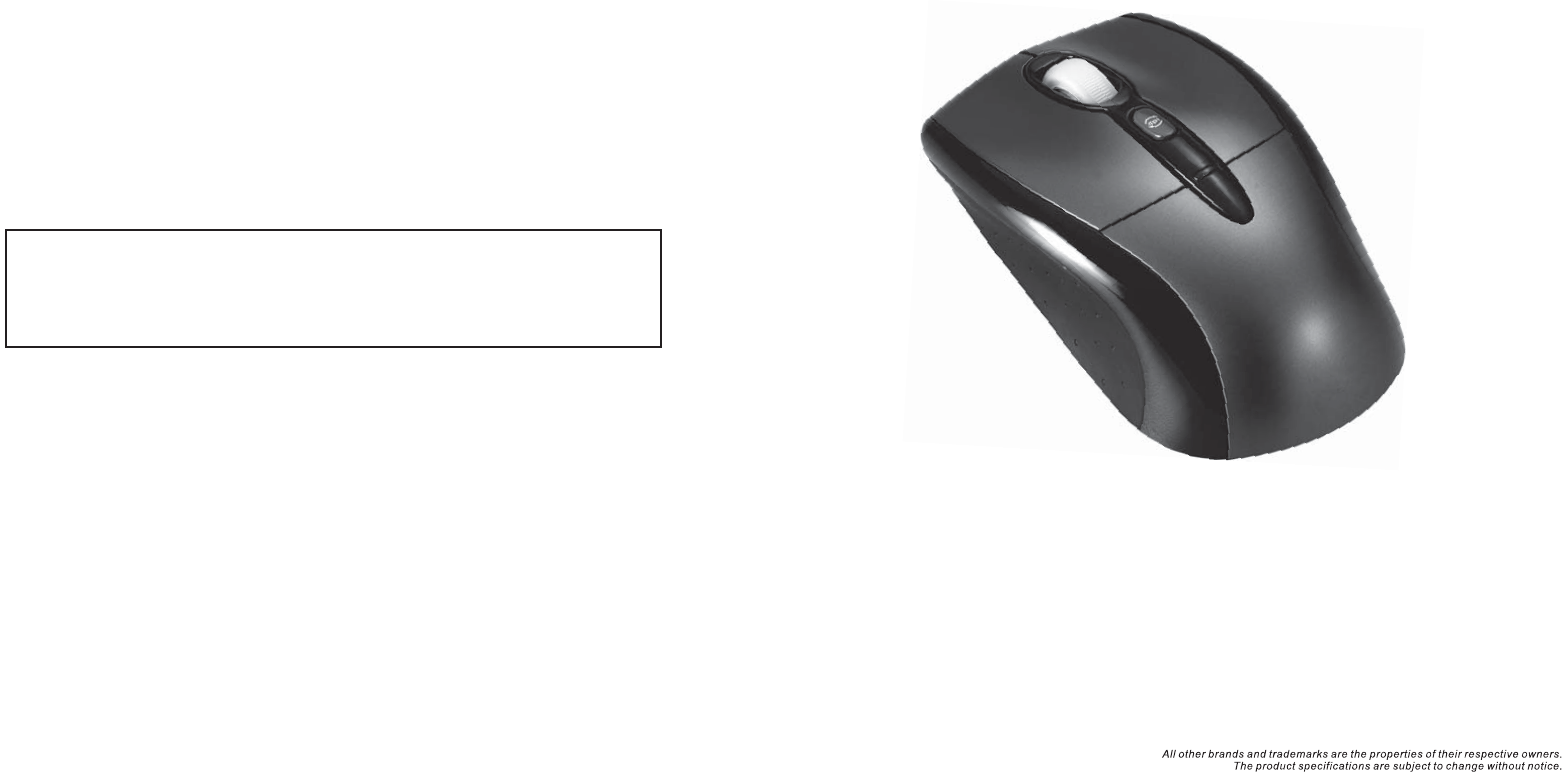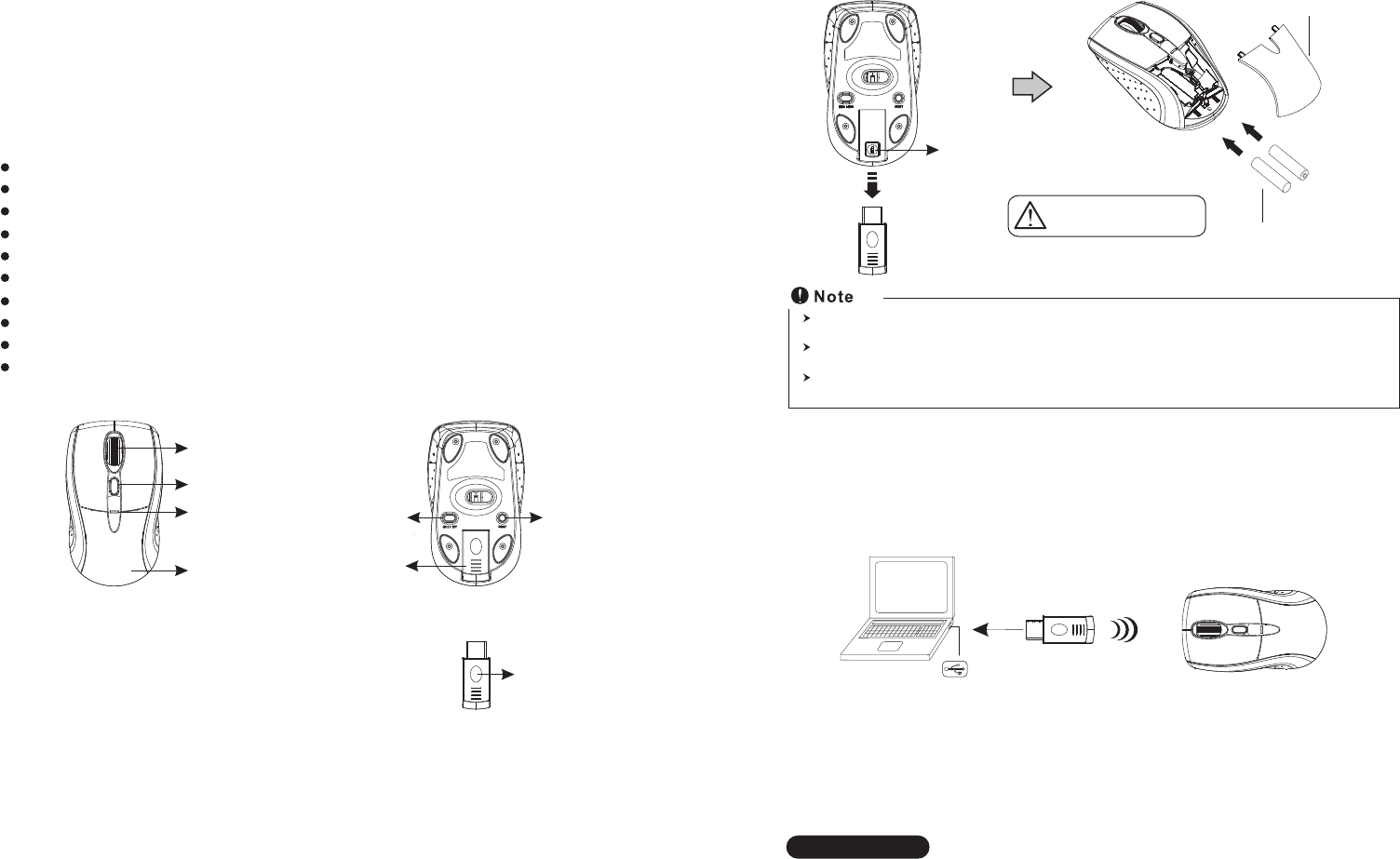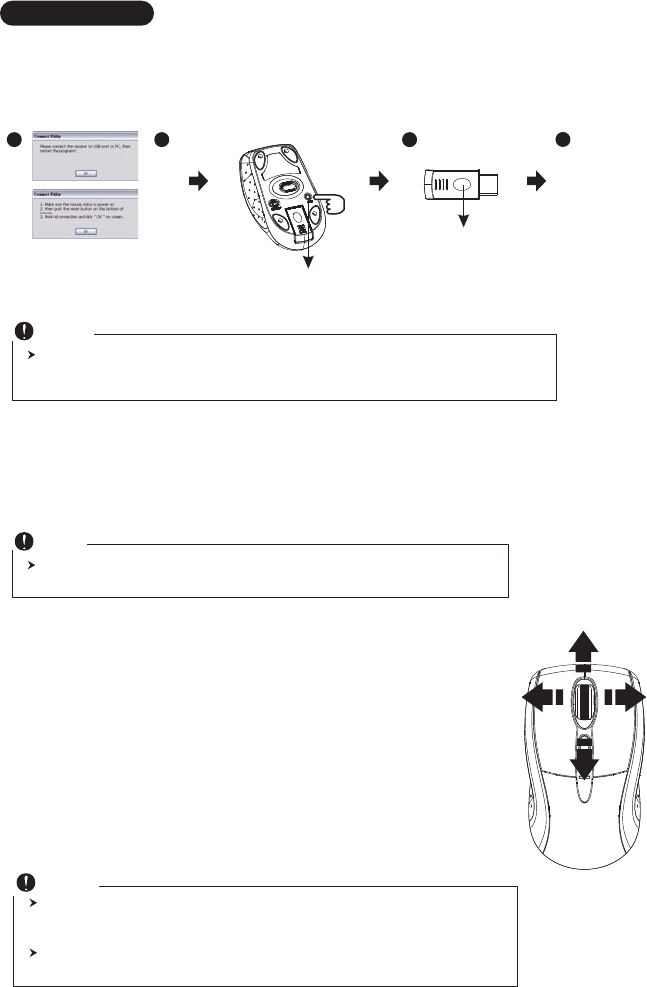ARESON Technology CB0007 Wireless Optical Mouse User Manual B180 4D manual cover
ARESON Technology Corp. Wireless Optical Mouse B180 4D manual cover
user manual

User's Guide
Mini Wireless
Optical Mouse
B-180
FCC statement
This equipment has been tested and found to comply with the limits for a class B digital device,
pursuant to Part 15 of the FCC Rules. These limits are designed to provide reasonable
protection against harmful interference in a residential installation.
This equipment generates uses and can radiate radio frequency energy and, if not installed and
used in accordance with the instructions, may cause harmful interference to radio
communications. However, there is no guarantee that interference will not occur in a particular
installation if this equipment does cause harmful interference to radio or television reception,
which can be determined by turning the equipment off and on, the user is encouraged to try to
correct the interference by one of the following measures:
● Reorient or relocate the receiving antenna.
● Increase the separation between the equipment and receiver.
● Connect the equipment into an outlet on a circuit different from that to which the receiver is
connected.
To assure continued compliance, any changes or modifications not expressly approved by the
party responsible for compliance could void the user's authority to operate this equipment.
(Example-use only shielded interface cables when connecting to computer or peripheral
devices).
FCC Radiation Exposure Statement
This equipment complies with FCC RF radiation exposure limits sent forth for an uncontrolled
environment. This equipment should be installed and operated with a minimum distance of 20
centimeters between the radiator and your body.
The antennas used for this transmitter must be installed to provide a separation distance of at
least 20cm from all persons and must not be co-located or operation in conjunction with any
other antenna or transmitter.
Channel
The Wireless Channel sets the radio frequency used for communication.
● Access Points use a fixed Channel. You can select the Channel used. This allows you to
choose a Channel which provides the least interference and best performance. In the USA and
Canada, 11 channel are available. If using multiple Access Points, it is better if adjacent Access
Points use different Channels to reduce interference.
● In "infrastructure" mode, Wireless Stations normally scan all Channels, looking for an Access
point. If more than one Access Point can be used, the one with the strongest signal is used.
(This can only happen within an ESS.)
IF using "Ad-hoc" mode (no Access Point), all Wireless stations should be set to use the same
Channel. However, most Wireless stations will still scan all Channels to see if there is an
existing "Ad-hoc" group they can join.
This device complies with Part 15 of the FCC Rules. Operation is subject to the following
two conditions:
(1) This device may not cause harmful interference. and
(2) This device must accept any interference received, including interference that may
cause undesired operation.

1. Insert the batteries
a. Take out the receiver on the bottom case first, press the battery cover release button on
the bottom of the mouse which is under the receiver.
b. Remove the battery compartment cover on the top case of the mouse.
c. Fit in the batteries accordingly to the diagram indicated in the battery cabinet.
d. Close the battery compartments cover properly.
e. Make sure the Power on-off swich on the bottom of the mouse is ON.
f. The Low Power LED in the wheel bar will blink 3 seconds if the mouse power is on.
Wheel button
Dpi button
Battery cover
ID reset button
LED indicator
Receiver
Mouse
Receiver
Introduction
Congratulations on your purchase of the most innovative wireless mini mouse. With an
incredible sensitivity to surface details and high tracking speed than other mice, the mouse
can track reliably even on tricky polished or wood-grain surfaces. It offers even more
advance that will make you more productive and more comfortable.
A. Hardware Installation
2.4GHz (distance 6~8m), 16 Channels/4096 ID
Using state-of-art technology. High tracking speed and sensitivity.
4-way scrolling.
Storable mini receiver
Longer battery life - 6~8 months.
Auto-Link, Plug and Play! No need to set the channel ID.
Power on/off switch
Data report rate : 125 Report/Sec.
800/1600 dpi switchable button.
2*AA Alkaline batteries included.
Power on/off
switch
Features
+
-
A wrong battery placement
may cause batteries overheat.
Battery compartment cover
2 * AA batteries
Battery cover
release button
Low power Led/
Power on indicator/
Dpi switching indicator
2. Connect the receiver
a. Turn on your PC.
b. Connect the receiver to USB port on PC.
PC
USB port
The unit offers a strong power saving management. Once the mouse accesses the sleeping mode, " to click any
button of the mouse" is compulsory to wake it up.
Power on/off:
There is a Power on/off switch designed to save the batteries power while non-usage of a longer period.
Users can push DPI button to change the resolution. The low power LED will be flashed when dpi has been
successfully swithced.
3. Communication : The mouse & the receiver
The 2.4Ghz RF mouse features a dual-way transmission technology which enables the
mouse and the receiver auto-communication.
A. Auto-link mode
1. Make sure the Power On-Off Switch on the bottom of the mouse is ON.
2. Operate the mouse, and the LED in the receiver will blink fast. Now the mouse and the
receiver is auto-linked successfully.

Press ID reset button
Execute ID connection
software
Led indicator
blinks faster
12 3
4
ID links OK!
4. Replace the new batteries
Please replace a pair of new batteries and follow the previous instructions. (2, 3)
The red LED on the scroll wheel is the low batteries power indicator. It indicates that
batteries inside the mouse are needed to be replaced.
Note
While the mouse is working, if encountering any interference, the mouse and the receiver will
automatically source out and transfer to another free channel. During the transferring, the
cursor movement may have a second delay.
Note
ɖ!Trouble Shooting
a. Make sure you have connected the receiver correctly to the computer's USB port.
b. For the best performance, we suggest you to locate the receiver with a distance from other electrical devices, such as the
computer, the computer monitor or external storage drives.
c. Make sure you have set the communication between the receiver and the mouse. Refer to the Communication :The
mouse and the receiver
d. If you find the communication channel does not connect well. You can use the software connection tool to re-connect
the mouse & receiver to reset a new channel ID. You are able to get the software from the included diskette of the
package or download from your local brand vendor's website.
e. Some system devices might conflict with the mouse. Confirm the IRQ/address settings of these devices for conflicts,
and change the settings as required.
f. Make sure that you are not working the mouse on glossy or reflective surfaces.
g. Try unplugging then reconnecting the receiver cable to your computer.
Ϩ!Battery use reminders
1. Remove worn-out batteries from equipment immediately and dispose of promptly.
2. Keep all batteries (used or new) out of the reach of children.
3. To have the batteries with a regular check and replace new batteries if not used for a long time.
4. Never dispose of batteries in fire, as they could explode.
5. Always replace all the batteries at the same time. Mixing old and new batteries or mining types (such as alkaline with
zinc carbon) will reduce overall performance and could cause leakage or rupture.
6. Do not mix different types of batteries (e.g. Ni MH, NiCd, alkaline, and etc) in the mouse.
7. Remove batteries from the electrical device if the device is not going to be used for a long time.
8. If the performance of the batteries decreases substantially, it is time to replace the batteries.
5. Operation
4-Way Scrolling:
a. Vertical Scrolling
Roll wheel up to scroll up; roll wheel down to scroll down.
b. Horizontal Scrolling
Hold the wheel to left to scroll left; hold the wheel to right to scroll
right. Release wheel to stop scrolling function.
B. Driver Installation
The mouse features plug & play. It is not necessary to install the driver to operate the mouse.
The driver is an optional item included. However if the model purchased is with 4-Way
Scrolling function, you may require the mouse software driver to make the 4-Way scrolling
function effective.
1. Un-install or removing the current mouse driver
Before installing the driver of the mouse, we suggest that you check if any other mouse
driver installed in your system. If yes, in order not to make conflict, please un-install or
remove that driver before installing the mouse.
2. Install the mouse 4-Way Scrolling driver
a.Select setup.exe to install the driver from the CD.
b.or you can download the 4-Way Scrolling driver from vendor's website.
B. Manual mode
If you find the communication channel does not connect well, you can use the software
connection tool to re-connect the mouse & receiver to reset a new channel ID. You are
able to get the software from the included diskette of the package or download from your
local brand vendor's website.
The 4-Way scrolling function is only effective under successful installation of the
original mouse driver. The driver is an optional item included in the package or it can
be downloaded from the website of your local brand vendor.
To function the 4-way scrolling in some applications in Window VISTA such as Word,
Excel, Powerpoint and etc., the driver should be installed.
Note